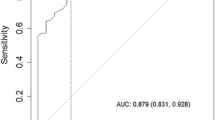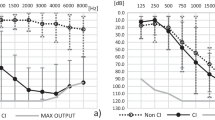Abstract
Hearing loss can be measured by pure-tone and speech audiometry. The subjective hearing impairment can be assessed using questionnaires. The APHAB determines this for four typical hearing situations. It has not been researched previously whether a particular frequency-specific hearing loss leads to a particular unaided APHAB score in one of the subscales or not. Clarification could be helpful using the unaided APHAB as an instrument for primary diagnostics of hearing loss independently of whether hearing aids were subsequently fitted or not. A total of 4546 records from a database were analysed; the average age of the subjects was 69.3 years. Using a multivariant mixed linear model, a possible correlation was examined between a frequency-specific hearing loss (0.5–8.0 kHz) and particular unaided APHAB scores for its subscales. Furthermore, it was determined whether the subject’s gender has a corresponding impact. There was no evidence of gender-specific dependence of the unaided APHAB scores. For the EC scale frequencies above 0.5 kHz, for the RV scale all frequencies and for the AV scale the frequencies at 1.0 and 2.0 kHz showed a significant correlation between hearing loss and the APHAB score. For each decibel of hearing loss there was an average rise in the APHAB score for the EC and RV scale of approximately 0.2 percentage points and an average decrease in the AV scale of 0.1 percentage points for each frequency. For the BN scale there was no evidence of this kind of correlation. The very varied possibility between individuals compensating for hearing loss in situations with background noises could be that there is no correlation between frequency-specific hearing loss and an associated unaided APHAB score. The described frequency-specific influence of hearing loss to the EC and RV score could be explained by fewer compensating possibilities for the patients in these specific hearing situations than for the BN scale described. Using the unaided APHAB form in primary diagnostics of hearing impairment is helpful for understanding individual problems.

Similar content being viewed by others
References
Schow RL, Gatehouse S (1990) Fundamental issues in self-assessment of hearing. Ear Hear 11(Suppl):6S–16S
Schow RL (1991) Considerations in selecting and validating an adult/elderly hearing screening protocol. Ear Hear 12:337–348
Wiley TL, Cruickshanks KJ, Nondahl DM, Tweed TS (2000) Self-reported hearing handicap and audiometric measures in older adults. J Am Acad Audiol 11:67–75
Cox RM, Alexander GC (1995) The abbreviated profile of hearing aid benefit. Ear Hear 16:176–186
Johnson JA, Cox RM, Alexander GC (2006) APHAB norms for WDRC hearing aids. Refereed poster presented at the annual meeting of the American Auditory Society, Scottsdale, AZ. http://www.ausp.memphis.edu/harl/downloads/posters/APHAB_norms_2006.pdf
Johnson JA, Cox RM, Alexander GC (2010) Development of APHAB norms for WDRC hearing aids and comparisons with original norms. Ear Hear 31:47–55
Löhler J, Frohburg R, Moser L (2010) The use of the German APHAB for quality control in hearing aid fitting in an ENT-office. Comparison of our results with the given US-norm. Laryngol Rhinol Otol 89:737–744
Löhler J, Moser L, Heinrich D, Hörmann K, Walther LE (2012) Results of clinical use of the German version of the APHAB. HNO 60:626–636
Löhler J, Akcicek B, Wollenberg B, Schönweiler R (2014) Implementation of the new quality assurance agreement for the fitting of hearing aids in daily practice. Part 1: new regulations pertaining to hearing aid fitting. HNO 62:605–612
Löhler J, Akcicek B, Wollenberg B, Schönweiler R (2014) Implementation of the new quality assurance agreement for the fitting of hearing aids in daily practice. Part 2: new diagnostic aspects of speech audiometry. HNO 62:667–682
Cox RM, Alexander GC, Gray GA (2003) Audiometric correlates of the unaided APHAB. J Am Acad Audiol 14:361–371
Löhler J, Akcicek B, Kappe T, Schlattmann P, Wollenberg B, Schönweiler R (2014) Development and use of an APHAB database. HNO 62:735–745
Brown ChA, Bacon SP (2010) Fundamental frequency and speech intelligibility in background noise. Hear Res 266:52–59
Moore BCJ (2014) Development and current status of the “Cambridge” loudness models. Trends Hear 18:1–29
Cox RM, Alexander GC, Gray G (1999) Personality and the subjective assessment of hearing aids. J Am Acad Audiol 10:1–13
Brainard SH, Frankel BG (1985) The relationship between audiometric and self-report measures of hearing handicap. Ear Hear 6:89–92
Cienkowski KM, Speaks C (2000) Subjective vs. objective intelligibility of sentences in listeners with hearing loss. J Speech Lang Hear Res 43:1205–1210
Ventry IM, Weinstein BE (1982) The hearing handicap inventory for the elderly: a new tool. Ear Hear 3:128–134
Doungkamol S, Mitchell P, Smith W, Golding M, Newall Ph (2001) Validation of self-reported hearing loss. The Blue Mountains Hearing Study. Int J Epidemiol 30:1371–1378
Valete-Rosalino C, Roznfeld S (2005) Auditory screening in the elderly: comparison between self-report and audiometry. Rev Braz Otolaryngol 71:193–200
Hoffmeister I, Menegotto CL, Soldera C, Anderle P, Anhaia TC (2011) Correlation between hearing loss and the results of the following questionnaires: Hearing Handicap Inventory for the Adults-Screening Version HHIA-S and Hearing Handicap Inventory for the Elderly-Screening Version—HHIS. Int Arch Otorhinolaryngol. doi:10.1590/S1809-48722011000300009
Diao M, Sun J, Jiang T, Tian F, Jia Z, Liu Y, Chen D (2014) Comparison between self-reported hearing and measured hearing thresholds of the elderly in China. Ear Hear e228–e232. doi:10.1097/AUD.0000000000000050
Author information
Authors and Affiliations
Corresponding author
Ethics declarations
This research is involving human participants. The participation itself and subjects’ participation for data storing were voluntary. The Ethics Commission of the Schleswig–Holstein Medical Association and the state data protection officer approved the research method.
Conflict of interest
None.
Funding
None.
Informed consent
All participants gave their informed consent in writing prior to inclusion in the study. All participants signed a declaration of informed consent for storing all of their anonymised data.
Rights and permissions
About this article
Cite this article
Löhler, J., Akcicek, B., Wollenberg, B. et al. The influence of frequency-dependent hearing loss to unaided APHAB scores. Eur Arch Otorhinolaryngol 273, 3587–3593 (2016). https://doi.org/10.1007/s00405-016-3966-9
Received:
Accepted:
Published:
Issue Date:
DOI: https://doi.org/10.1007/s00405-016-3966-9




